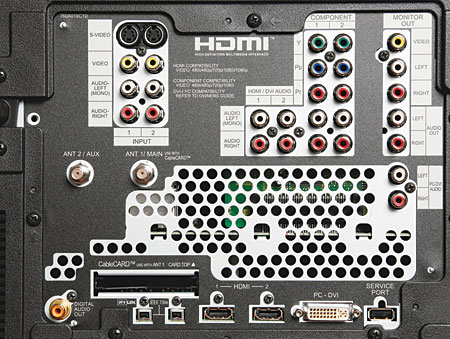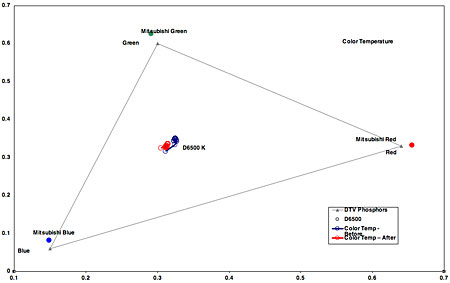The 2007 1080p RPTV Face Off Mitsubishi WD-65731 DLP HDTV
For the want of a black level.
Much like the Olevia, there was one major thing and one slightly less major thing that conspired to drop the WD-65731 down in the rankings. These were black level and edge enhancement.

At 0.127 foot-lamberts, the Mitsubishi's black level was more than 3.5 times as high as the second worst one. Not only is this a lot higher than the others in this test, but it is significantly higher than most of the other displays we've reviewed lately (even LCD flat panels). Unfortunately, the WD-65731 didn't have a high enough light output to offset the high black level. While 98.7 ft-L is certainly high (although about average in this test), it made for an overall contrast ratio of only 777:1. This is low for an RPTV. The interesting thing is that there weren't many comments about the black level being too high. In fact, Michael was the only one who commented on it looking rather high. This was probably due to the fact that the ANSI contrast ratio, which is more similar to what you'll see on the screen, was slightly above average at 385:1. Most RPTVs have terrible ANSI contrast ratios due to the amount of reflections that happen inside the cabinet (among other things). Mitsubishi had the best ANSI contrast in last year's Face Off. This year's model is slightly lower than that, but two other sets (the Toshiba and the Samsung) both made large strides in increasing their ANSI compared with last year's models.
 The other main negative is disappointing on several levels. More than the others, the WD-65731 had noticeable and non-defeatable edge enhancement. At first glance, this makes the Mitsubishi look detailed. On closer inspection, however, you can see thin white halos running along all of the edges. Displays use edge enhancement typically when, for some reason, they don't have the resolution to look detailed on their own. Ironically (and sadly), the WD-65731 has that detail. It was one of only three displays (and the only DLP) that passed the one-pixel-on/one-pixel-off test both horizontally and vertically. So, the resolution is there, but the edge enhancement covers it up. This was also the noisiest TV in the Face Off, and each reviewer commented on how noisy the image looked. This could be due in part to the overactive edge enhancement. Like the Samsung in last year's Face Off, this set would have looked a lot better without that extra processing.
The other main negative is disappointing on several levels. More than the others, the WD-65731 had noticeable and non-defeatable edge enhancement. At first glance, this makes the Mitsubishi look detailed. On closer inspection, however, you can see thin white halos running along all of the edges. Displays use edge enhancement typically when, for some reason, they don't have the resolution to look detailed on their own. Ironically (and sadly), the WD-65731 has that detail. It was one of only three displays (and the only DLP) that passed the one-pixel-on/one-pixel-off test both horizontally and vertically. So, the resolution is there, but the edge enhancement covers it up. This was also the noisiest TV in the Face Off, and each reviewer commented on how noisy the image looked. This could be due in part to the overactive edge enhancement. Like the Samsung in last year's Face Off, this set would have looked a lot better without that extra processing.
The Mitsubishi's 3:2 pickup with 480i was about average, and, like most of the other TVs, the Mitsubishi didn't pick it up with 1080i. Its video deinterlacing with 480i resulted in some jagged edges on the flag, but its 1080i deinterlacing was fine.
The color points, while not as accurate as the Samsung's, were more accurate than those of all of the other sets here. The new remote is smaller and easier to use than the old one. It's pretty basic, but the important bits are backlit.
Decrease the black level and the edge enhancement, and you'd have an OK TV. Would those improvements have moved it up in the rankings? I don't know. From here on up, the competition got really heated.
Highlights
• The only DLP in the Face Off able to do one pixel on/one pixel off
At A Glance: Mitsubishi WD-65731 DLP HDTV

Connections
Inputs:
Video: HDMI (2), DVI (1), component video (2), S-video (3, shared), composite video (3, shared)
Audio: None
Outputs:
Video: Composite Video (1)
Audio: Stereo analog (1), coaxial (1), RF (2)
Additional: CableCARD (1), FireWire (2)
Features
Type: DLP
Screen Size (diagonal): 65 inches
Native Resolution: 1080p
Lamp Life: NA
Dimensions (H x W x D, inches): 40.8 x 58.5 x 19.8
Weight (pounds): 99
Price: $3,500
Ratings: Mitsubishi WD-65731 DLP HDTV
Build Quality: 88
Value: 86
Features: 91
Performance: 85
Ergonomics: 87
Overall Rating: 87
General Information
WD-65731 DLP HDTV, $3,500
Mitsubishi Digital Electronics
(800) 332-2119
www.mitsubishi-tv.com
Dealer Locator Code MSU
HT Labs Measures: Mitsubishi WD-65731 DLP HDTV


Full-On/Full-Off Contrast Ratio—777:1; ANSI Contrast Ratio—385:1
Measured Resolution with the Leader LT-446:
480: 480 (per picture height)
720p: 720 (pph)
1080i: 1,080 (pph)
DC Restoration (poor, average, good, excellent): Excellent
Color Decoder (poor, average, good, excellent): Average (Adjustable to Good)
Measured Color Points:
Red Color Point: x=0.655, y=0.333
Green Color Point: x=0.291, y=0.626
Blue Color Point: x=0.149, y=0.082
The left chart shows the WD-65731's gray scale relative to its color temperature at various levels of intensity, or brightness (20 IRE is dark gray; 100 IRE is bright white). The gray scale as set by the factory, in the Low color-temperature mode and the Natural picture mode, measures a little cool with the darkest images, but fairly warm across the rest of the gray scale. After making adjustments using the Photo Research PR-650, the gray scale measures better, although the darkest images are still cool compared with D6500, the accurate color temperature, across the entire range.
The right chart shows the gray scale (or color temperature) relative to the color points of the display's red, green, and blue color-filter-wheel segments. These are somewhat off those specified by SMPTE. Red is somewhat oversaturated. Blue is somewhat greenish-blue. Green is somewhat oversaturated and slightly bluish-green.
After calibration, and using a full-field 100-IRE white (98.72 foot-lamberts) and a full-field 0-IRE black (0.127 ft-L), the contrast ratio was 777:1. Using a 16-box checkerboard pattern (ANSI contrast), the contrast ratio was 385:1.—GM





























































